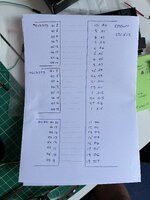Freddy flint
Newbie level 5

I’m trying to connect an eprom containino 3 simple lines of machine code as a test. The code is mov ax, 45
add ax, 7
mov [6000], ax
I have two 8 bit 512 eproms, as the 8086 reads 16 bits of data and eproms have 16 address lines and 8 data lines
The 16 address lines connect to both eproms a0 to a15 inputs via two 74ls373 latches
On one eprom I have d0 to d7 data lines and on other d8 to d15, to allow 16 bits to be read. The two eproms have the machine code loaded identically, and idea is the 8086 will read the 16 bits as one read. On reset the cpu sets the address to FFFFO so I have the code in eprom loaded at FFF0 to FFFA. On reset the address presented to the 2 eproms via the latches is FFF0. But I’ve hit a problem as I have the two eproms connected to the address with eprom chip enable held low and chip select connected to the read output of cpu. But both eproms have address FFF0. So do I connect A0 of the 2nd eprom high, so that first address on eprom one is FFF0 and other EPROM address is FFF1, on the next cycle the instruction pointer moves to FFF2 but as I have 2nd eprom with a0 address held high it should have FFF3 ? Is that how it works and how the cpu can read 16 bits with 8 from one and 8 from 2nd, or is it more complex ?
add ax, 7
mov [6000], ax
I have two 8 bit 512 eproms, as the 8086 reads 16 bits of data and eproms have 16 address lines and 8 data lines
The 16 address lines connect to both eproms a0 to a15 inputs via two 74ls373 latches
On one eprom I have d0 to d7 data lines and on other d8 to d15, to allow 16 bits to be read. The two eproms have the machine code loaded identically, and idea is the 8086 will read the 16 bits as one read. On reset the cpu sets the address to FFFFO so I have the code in eprom loaded at FFF0 to FFFA. On reset the address presented to the 2 eproms via the latches is FFF0. But I’ve hit a problem as I have the two eproms connected to the address with eprom chip enable held low and chip select connected to the read output of cpu. But both eproms have address FFF0. So do I connect A0 of the 2nd eprom high, so that first address on eprom one is FFF0 and other EPROM address is FFF1, on the next cycle the instruction pointer moves to FFF2 but as I have 2nd eprom with a0 address held high it should have FFF3 ? Is that how it works and how the cpu can read 16 bits with 8 from one and 8 from 2nd, or is it more complex ?


